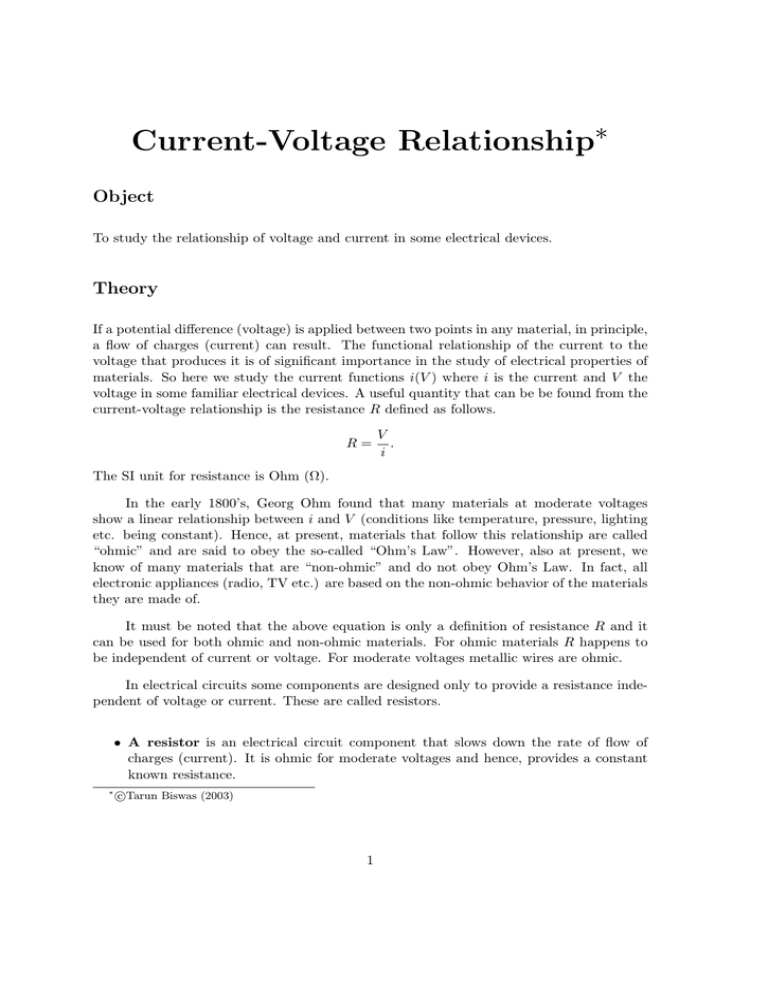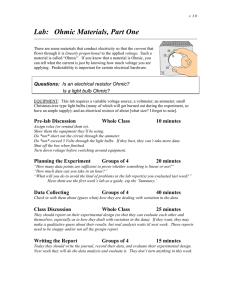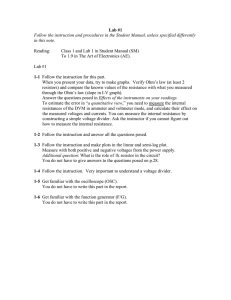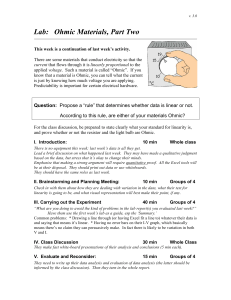Current-Voltage Relationship
advertisement

Current-Voltage Relationship∗ Object To study the relationship of voltage and current in some electrical devices. Theory If a potential difference (voltage) is applied between two points in any material, in principle, a flow of charges (current) can result. The functional relationship of the current to the voltage that produces it is of significant importance in the study of electrical properties of materials. So here we study the current functions i(V ) where i is the current and V the voltage in some familiar electrical devices. A useful quantity that can be be found from the current-voltage relationship is the resistance R defined as follows. R= V . i The SI unit for resistance is Ohm (Ω). In the early 1800’s, Georg Ohm found that many materials at moderate voltages show a linear relationship between i and V (conditions like temperature, pressure, lighting etc. being constant). Hence, at present, materials that follow this relationship are called “ohmic” and are said to obey the so-called “Ohm’s Law”. However, also at present, we know of many materials that are “non-ohmic” and do not obey Ohm’s Law. In fact, all electronic appliances (radio, TV etc.) are based on the non-ohmic behavior of the materials they are made of. It must be noted that the above equation is only a definition of resistance R and it can be used for both ohmic and non-ohmic materials. For ohmic materials R happens to be independent of current or voltage. For moderate voltages metallic wires are ohmic. In electrical circuits some components are designed only to provide a resistance independent of voltage or current. These are called resistors. • A resistor is an electrical circuit component that slows down the rate of flow of charges (current). It is ohmic for moderate voltages and hence, provides a constant known resistance. ∗ c Tarun Biswas (2003) 1 The measurement method In this experiment we shall use the defining equation (as given above) to directly measure resistance. The voltmeter that measures V and the ammeter that measures i are connected as follows to the resistor that needs measurements. ............... ............. ................. V .......voltmeter ... .. ............... ... .. ... . . . . . . . . . . . . . . . . ... .... i . . ammeter . . ∧∧∧∧∧∧∧ . . . . ................ A ............. .........•....... .....•......................... .. ............... .. ... .. ... .. ... ............................................................ ........................................................... power source Note that a wire needs to be “broken” to place the ammeter in it. This is because the ammeter is measuring a flow of charges and these charges must actually flow through the ammeter for it to be able to make the measurement. The voltmeter, on the other hand, measures the difference of potentials between two points. Hence, its ends must be brought in contact with the two points in question. An instrument called the multimeter will be provided to you. This can be used either as a voltmeter or as an ammeter depending on what setting it is on. Seek the instructor’s help to learn to use the multimeter. The “pump” that drives the current in the circuit is an electronic power supply that can be set to different voltages by turning a knob. For any given device, measure currents for a range of voltages. Choose appropriate ranges of voltages for each device based on how sensitive current measurements are to voltage changes. Use Excel to record your data. Using the formula for resistance, find the resistance at each data point. See if the material can be considered ohmic. Another way of testing a material for ohmic behavior is to check how well a straight line fits the current-voltage graph. Some trials Find the voltage-current relationship for the devices provided (resistor, lamp etc.). With the instructor’s consent, you can try out any other device as well. It is well-known that the lamp filament is ohmic. However, it shows significantly changing resistance. See if you can think of the reason. Look for the stamped value of internal resistance for the voltmeter. You need to keep the measured resistances significantly lower than this. Why? 2







